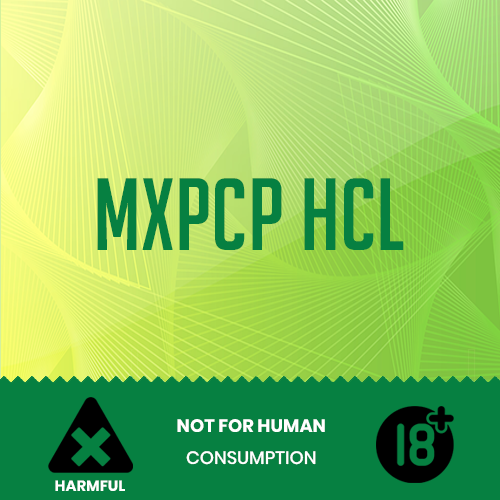MXPCP

Understanding MXPCP: A Brief Introduction
Chemical Composition and Structure
MXPCP, known scientifically as 2-(3-methoxyphenyl)-2-(piperidin-1-yl)cyclohexan-1-one, is a fascinating compound within the realm of research chemicals. Its structure is characterised by a cyclohexanone core, which is a prevalent motif in many organic compounds, imparting distinct chemical properties. Attached to this core is a piperidine ring, which modifies its pharmacological profile. The presence of a methoxyphenyl group further adds to its complexity, influencing both its physical and chemical behaviour. This unique combination of structural elements is what gives MXPCP its intriguing chemical identity, setting it apart from related compounds.
Pharmacological Profile
The pharmacological characteristics of MXPCP are an area of active investigation. Researchers are particularly interested in its potential interactions with various neurotransmitter systems. Understanding MXPCP's biochemical interactions could provide insights into its effects and potential applications. While the full spectrum of its pharmacodynamic properties is still being uncovered, preliminary findings suggest that its mechanism may involve modulation of receptor activity, akin to other arylcyclohexylamine derivatives. Such interactions highlight MXPCP's potential as a tool in neuropharmacological research.
Safety and Ethical Considerations
In exploring the chemical profile of MXPCP, safety and ethical considerations are paramount. Researchers must adhere to strict guidelines to ensure experiments are conducted responsibly, minimising any potential risks associated with handling and studying such compounds. Ethical frameworks not only govern the responsible use of MXPCP but also guide the dissemination of research findings. These protocols ensure that scientific inquiry into MXPCP contributes positively to the broader understanding of chemical compounds, while safeguarding both researchers and the environment.
Chemical Structure and Properties of 2-(3-methoxyphenyl)-2-(piperidin-1-yl)cyclohexan-1-one
Molecular Configuration and Composition
The chemical structure of 2-(3-methoxyphenyl)-2-(piperidin-1-yl)cyclohexan-1-one, known commonly as MXPCP, is a unique arrangement of atoms that contributes to its distinctive properties. At the core of this compound is a cyclohexanone ring, a six-membered ring fused with a ketone group, which serves as a central scaffold for additional molecular groups. This ring is functionalised with a 3-methoxyphenyl group, an aromatic moiety that introduces electron-withdrawing characteristics, potentially impacting the compound's reactivity and solubility.
Role of the Piperidinyl Group
Attached to the cyclohexanone ring is a piperidin-1-yl group, a saturated heterocyclic amine that significantly influences the compound's pharmacological profile. This group imparts notable basicity and enhances the lipophilicity of MXPCP, thereby affecting its absorption and distribution within biological systems. The presence of this group is crucial in modulating the interaction with various receptors, which is pivotal in pharmacodynamic studies.
Physicochemical Properties
MXPCP exhibits a combination of physical and chemical properties that are of interest to researchers. Its molecular weight contributes to its stability and potential for crossing biological membranes, while its 3-methoxyphenyl moiety may influence its binding affinity with target proteins. Understanding these properties is vital for assessing the compound's potential applications and safety profile. Researchers also focus on its stereochemistry, as the spatial arrangement of its atoms can profoundly affect the compound's biological activity and efficacy.
By examining these structural and physicochemical elements, one gains insights into the nuanced behaviour of MXPCP, paving the way for further exploration of its capabilities in scientific and pharmaceutical contexts.
Research Applications and Potential Uses of MXPCP
Pharmacological Exploration
The chemical structure of MXPCP, characterised by its IUPAC name 2-(3-methoxyphenyl)-2-(piperidin-1-yl)cyclohexan-1-one, offers intriguing possibilities within the field of pharmacology. Its molecular configuration suggests potential activity as an NMDA receptor antagonist, a class of compounds often investigated for their effects on brain function and cognition. This makes MXPCP a candidate for research into neurological conditions, exploring how its interaction with neural pathways might contribute to our understanding of disorders like depression, schizophrenia, and Alzheimer's disease.
Neuroscience Research
MXPCP presents a valuable tool for neuroscientists aiming to delve into the complexities of synaptic transmission and neuroplasticity. Its potential to modulate neurotransmitter activities could provide insights into the mechanisms of synaptic strength and plasticity, essential components of learning and memory. By experimenting with MXPCP in controlled environments, researchers might uncover new dimensions of how neural circuits adapt and reorganise in response to external stimuli, which could inform therapeutic strategies for cognitive impairments.
Chemical and Biological Studies
Apart from its neurological implications, MXPCP can also serve as a subject in chemical and biological studies focusing on receptor-ligand interactions. Its unique aromatic and cyclic components offer a rich framework for investigating the binding affinities and selectivity of chemical compounds towards specific receptors. This could pave the way for the synthesis of novel compounds with tailored pharmacological profiles, potentially benefiting drug discovery and development processes.
Collectively, MXPCP's diverse research applications highlight its significance as a compound worth exploring, with the potential to contribute substantially to various scientific and clinical advancements.
Safety Considerations and Legal Status of MXPCP
Understanding Safety Precautions
When exploring the chemical profile and potential applications of MXPCP, it is crucial to underscore the importance of safety. As with any research chemical, comprehensive safety protocols must be observed to mitigate health risks. Researchers should employ appropriate personal protective equipment (PPE), such as lab coats, gloves, and safety goggles, to prevent exposure. Additionally, conducting experiments within a controlled laboratory setting equipped with proper ventilation systems is highly recommended to avoid inhalation or accidental ingestion. Familiarity with the chemical's material safety data sheet (MSDS) can provide valuable insights into its properties and handling precautions.
Evaluating Health Implications
The health implications associated with MXPCP are not fully understood, necessitating a cautious approach to its use. Potential toxicological effects require thorough investigation to ascertain any short- or long-term impacts on human health. As the compound’s pharmacological and toxicological profile is still under study, researchers are urged to conduct detailed assessments to identify any potential adverse effects. This is of paramount importance to ensure the safety of those involved in research and to inform appropriate regulatory actions.
Navigating Legal Considerations
The legal status of MXPCP varies significantly across different jurisdictions, reflecting its classification under diverse regulatory frameworks. Before engaging in research or development involving this compound, it is critical to verify its legality within the relevant region. In many areas, MXPCP may fall under stringent regulations due to its potential psychoactive properties. Researchers must ensure compliance with all applicable laws and obtain necessary permits or licences to conduct their work legally. Failure to adhere to legal requirements could result in severe penalties, underscoring the importance of thorough legal consultation and adherence.
Future Directions in MXPCP Research and Development
Expanding Chemical Understanding
One of the foremost directions in MXPCP research and development is the deepening understanding of its chemical intricacies. Scientists are keen to explore the structure-activity relationship (SAR) of MXPCP to better comprehend how its molecular components influence its overall activity. This involves synthesising analogues and examining their pharmacological profiles. Such research not only provides insights into MXPCP's functionality but also opens avenues for the design of new compounds with potentially enhanced efficacy and safety profiles.
Safety and Efficacy Assessments
Safety remains a critical concern in MXPCP research. Comprehensive toxicological evaluations are vital to ascertain potential risks associated with its use. Future studies will likely focus on long-term exposure effects and dose-response relationships, crucial for determining therapeutic windows. Researchers may employ advanced in vitro and in vivo models to gather more precise data, ensuring robust safety assessments. Furthermore, efficacy studies might explore MXPCP’s potential applications in various therapeutic areas, expanding its utility beyond current boundaries.
Technological Advancements in Research
The evolution of analytical technologies offers promising prospects for MXPCP research. Techniques like high-throughput screening (HTS) and computer-aided drug design (CADD) are expected to accelerate the discovery process by identifying active compounds more efficiently. Additionally, advancements in bioinformatics and molecular modelling can provide detailed insights into MXPCP's interaction mechanisms at a molecular level. These technological tools not only enhance research capabilities but also facilitate the development of tailored interventions with higher success rates.
Collaborative and Interdisciplinary Efforts
Finally, fostering interdisciplinary collaborations could significantly propel MXPCP research forward. By integrating expertise across fields such as pharmacology, chemistry, and computational biology, researchers can address complex challenges more effectively. Such collaborations could lead to innovative approaches in MXPCP development, ultimately translating laboratory findings into real-world applications, and broadening our understanding of this intriguing compound.
Conclusion
In exploring the chemical profile of MXPCP, you gain valuable insight into its complex molecular structure and potential applications. As the research community delves deeper into the intricacies of 2-(3-methoxyphenyl)-2-(piperidin-1-yl)cyclohexan-1-one, your understanding of its properties can inform both scientific inquiry and practical implementation. This compound's unique characteristics present promising avenues for further study, inviting researchers to unlock its full potential. By remaining abreast of ongoing developments, you position yourself at the forefront of chemical innovation, contributing to a deeper understanding of MXPCP and its implications for the broader field of synthetic chemistry.
This product is not intended for human consumption, it is sold for research purposes only. Keep it away from children and pets. Always use protective equipment during research.

MXPCP
- Brand: Research Chemicals
- Product Code: mxpcp
- Only Ships to: Worldwide (Excluding USA and UK)
- Availability: In Stock
-
£42.00
Available Options
| Quantity | |
|---|---|
| 5 - 9 | £40.00 |
| 10+ | £36.00 |
Related Products
4-ACO-MET
New variety of Research Chemicals will be added to our catalogue in the next few weeks.Germany, Aust..
£58.39
3-FEA
New variety of Research Chemicals will be added to our catalogue in the next few weeks.Germany, Aust..
£23.33
AB-CHMINACA 2g
This product has been discontinued.Germany, Austria, Denmark, Sweden, Iceland, Finland, Norway - Res..
£41.00
A-PIHP
New variety of Research Chemicals will be added to our catalogue in the next few weeks.Germany, Aust..
£12.50
Recently Purchased Products
Clipper Flint Large 12blisters/3pcs
Introducing the Clipper Flint Large 12blisters/3pcs, your ultimate sidekick for lighting up those mo..
£18.07
Waterpipe Bottle Blue Heaven 16cm
Looking for a compact, stylish waterpipe? The Waterpipe Bottle Blue Heaven, available at our Headsho..
£3.63
Roller pipe Chrome 8 cm
Hey, fellow smokers! Ready to roll up your smoke sessions with style? Introducing the Roller Pipe Ch..
£6.38
Roller pipe brass 8 cm
Looking for something small but mighty for your smoking needs? Meet the Roller Pipe Brass 8 cm, avai..
£6.86












